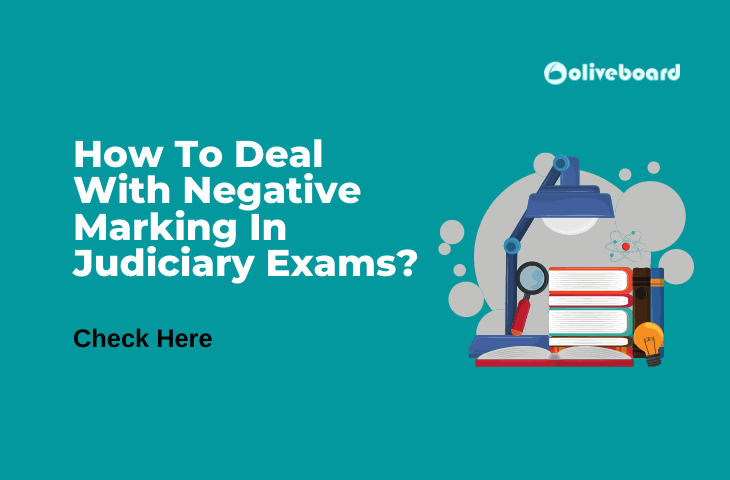Well, we have the way out of this problem. Whenever the idea of attempting a multiple-choice question comes to mind, the quintessential method of choosing the answer by blabbering ‘Jai Mata Di’ (not to take any offense of it) instantly comes to the mind of an Indian aspirant and unbelievably some of such wild guesses even yield some marginal marks. Nevertheless, the moment an objective-based question has a pattern that entails negative marking for each wrong answer, all these ideas become futile. Many examinations like Delhi Judicial Services, Haryana Judicial Services, or even some other law-related exams like Assistant Prosecution Officer Exam recently conducted by Bihar Public Service Commission impose negative marking for wrong attempts and this process is greatly responsible for fluctuating overall cutoff fixed by the respective conducting bodies. A negative marking pattern emerges as the game-changer in determining who gets on the merit list and who does not. Many a time, several candidates who answered most of the answers rightly do not find their name or roll numbers in the merit list as the number of questions they had wrongly attempted makes them fail to clear the cut off by a narrow margin. Alas!!! They fail to qualify the preliminary stage of judicial services examination, let alone the mains and viva voce stage. In general parlance, the preliminary examinations are qualified by candidates in ten times the number of vacancies, for instance in Bihar Judicial Services or even fifteen times in certain states, and this percentage shrinks at the mains stage and even further at interview stage, so it is safe to presume that preliminary rounds welcome the most number of candidates.
It is, therefore, better to adopt a positive attitude towards preliminary rounds entailing negative marking rather than making it a big fuss or rocket science. So we present you few rules which may turn out to be a useful means in your dream job.
The first amongst the few golden rules to ace the negative marking examinations is to:
- Legal Common-Sense: Thoroughly read a question by giving it at-least one-two minute and ascertaining what the question demands. For instance, if a question is framed so as to test the candidate’s knowledge of what are the particulars of a judgment as enshrined in Section 353 of Code of Criminal Procedure, 1973, a candidate needs to mentally locate Section 353 and mentally rewind what qualifiers were needed to be fit in a judgment. Logically speaking, if one of the options mentions the facts and issues of the case it would be naturally correct. Similarly, if one of the options mentions rationale for arriving at the judgment, this too would be logically correct. However, if one of the options mentions the details of names and particulars of a victim of rape, a candidate can simply weed out this option as the general principle of criminal law is to conceal the identity of a rape victim in her best interests. Therefore, certain options can simply appear as right or wrong if a candidate has a cursory idea of the provisions relating to it.
- Ignoring: Avoid attempting a question that revolves around a topic completely alien to a candidate. The chances of choosing an incorrect option are more in cases where one has no idea what the question demands, let alone knowing the options.
- Reverse Reading: Sometimes it is productive to read the question thoroughly and then carefully read the options and re-read the question again after reading the options as post-reading the options well one gets the required idea as to what options appear suitable for the answer demanded by the question; thereby leading to the correct answer.
- Elimination: Moreover, another golden rule to attempt such questions and eliminate chances of negative marking is to read attempt the questions that you are completely sure about first and count the estimated marks that you might score by virtue of such sure shot questions from the first question to the nth or the last question. Now counting these questions could give you the idea of how much near or far your estimated score lies as regards 70 percentage of the consolidated marks. The nearer you appear to be around the cutoff that you anticipate given the nature of cutoff set by the particular Judicial Services exam in the previous years, the less adventure you must partake by attempting questions in which you face a dilemma. Marking incorrect answers ultimately leads to a reduction of the overall score by the negative marking.
Let us suppose that marking an unsure question is no less than an adventure, an adventure that exposes a candidate to the risk of being eliminated from the race for mains examination. It is, therefore, safe to attempt the questions that involve risk according to your score in the rightly marked questions so that you attempt just the number of questions that can put you through the final cutoff that is later set for the paper.
As the underlying objective behind this approach is the safe play, it would be in the best interests of candidates to further demarcate the unattended questions into two categories:
- 50-50 hit: One would be as per the 50-50 hit: i.e., the questions in which you are certain that one of two options is perhaps the correct answer. In such cases, the chances of hitting the right answer are most likely. The questions of this nature fetch you the most marks, hence a candidate must try to attempt all questions from this chosen demarcation to fulfill the cutoff requirement.
Another set of questions is such that involves confusion amongst three options, in such cases naturally the risk of hitting the incorrect option is quite high. Therefore, these questions must be attempted only when a candidate considers that the earlier safe set of questions that you had demarcated are not sufficient enough to generate for you the required cutoff.
- The norm of proximity vis-a-vis connecting the dots: Another golden rule is to link the options with the question and analyze which of the following options can be best linked with the question, more or less like a key to a lock. Consider the options as generating various keywords for you, if the number of keywords that appears most relevant and suitably fit the question is most probably the correct option. For instance, if the question seeks you to answer in which chapter the provisions of arrest are enshrined in the Code of Criminal Procedure, 1973, the first thing that must come to your mind is that the sections governing arrest are incorporated around Section 41-60A, hence the chapter that covers arrest must be amongst the first ten chapters of the Code of Criminal Procedure, 1973. As you gather this rider the task is easier now, the only thing that has to be done is search amongst the options that mention the first few chapters, the ones that logically seem to be incorporating Sections 41-60A can well be determined as being in Chapter V. Thus the art of finding the option that bears most resemblance or proximity to the question can be safely adhered to in order to hit the bullet on the target.
- Practicing Mocks: However, the most classical golden rule would be to solve as many multiple choice questions as possible that have been asked in the state which conducts the targeted judicial services exam so as to gauge the nature of questions asked and prepare systematically. This inbuilt knack is the most helpful in clearing exams with negative markings for an overwhelming victory. Additionally, solving mock tests well-crafted for the targeted exam, as is routinely served for candidates by Oliveboard is another ‘Ramban’ for honing a candidate’s skill in attempting questions with negative marking. All the more, Oliveboard serves elaborate answer keys also to clear any doubt that springs up in the mind of a candidate who might have answered a question incorrectly.
Precisely put, there cannot be zillions of ways to attempt a question correctly, only acumen can be the savior but to avoid attempting an incorrect option can have many such strategies to avoid being negatively marked, the above-mentioned are only a few but cardinal ones that have been religiously advocated by those who fight the negative marking pattern with their dedication and secure a place in Judicial Services.

Dikshant (DJ) is an engineer turned banker. He has cleared many competitive exams before his current placement. Being an officer in the bank, DJ is super busy but makes sure that he always finds time for writing informative & exam-oriented content to help students in cracking competitive exams such as SBI, IBPS, SSC, JAIIB/ CAIIB and many more.
Oliveboard Live Courses & Mock Test Series

